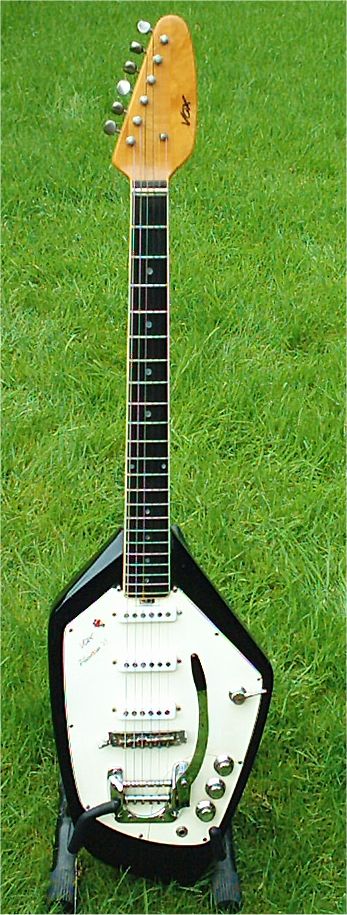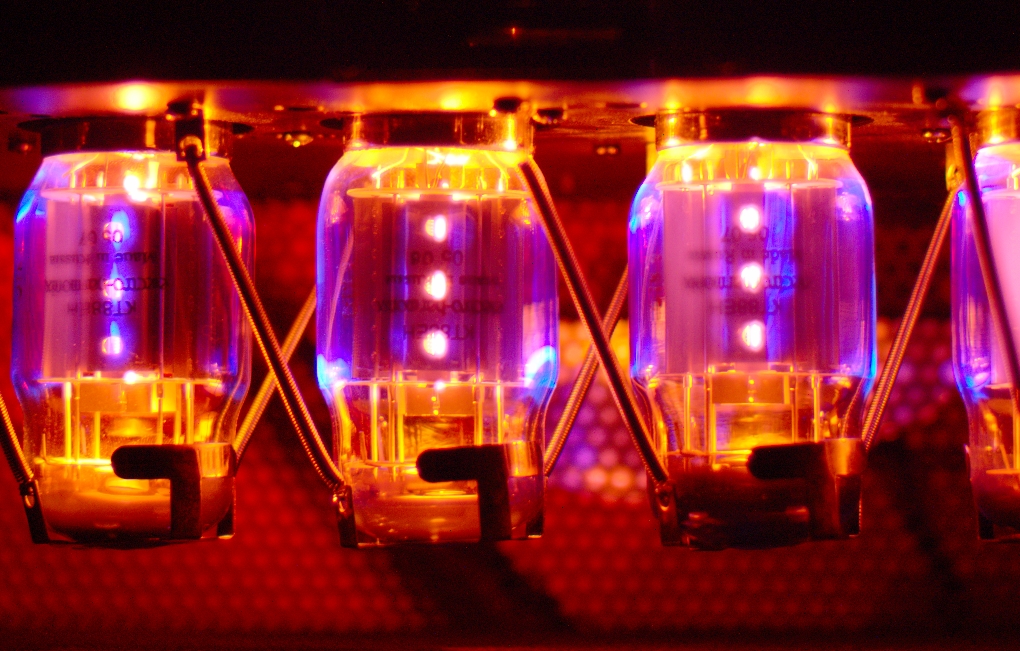|
Marshall JTM 45
The Marshall JTM45 amplifier is the first guitar amplifier produced by the British company Marshall. It was initially produced in 1963, and has been ranked among the most desirable of the company's amplifiers. Notable musicians who have used this amplifier include David Gilmour, The Rolling Stones, and Jimi Hendrix, among others. History and development Prototyping of the JTM45 began in 1962, after London musical instrument retailer Jim Marshall decided to create a new amplifier in response to local guitarists' desire for an alternative to imported American Fender amplifiers. Marshall sought the advice of his shop repairman Ken Bran, who recommended electronics " whiz kid" Dudley Craven as the chief circuit designer. Marshall then arranged for Pete Townshend and Ritchie Blackmore demo prototypes to be constructed by Bran and Craven, settling on the sixth prototype as the production model. This model was dubbed the "JTM45" – for Jim and his son Terry Marshall, and 45 fo ... [...More Info...] [...Related Items...] OR: [Wikipedia] [Google] [Baidu] |
JTM 45 MK II Reissue 1997
JTM may refer to: * Jordan Transverse Mercator, a grid system * Jornal Tribuna de Macau, a Portuguese newspaper in Macau * Marshall JTM45, a guitar amplifier * Jasons Travel Media Jasons is a publisher of travel guides and an online directory of activities and lodging in New Zealand, Australia, and the South Pacific. Jasons produces 62 free travel guides annually. History The company was started as a family business in 196 ..., a New Zealand website * JTM (born 1986), an American rapper {{disambig ... [...More Info...] [...Related Items...] OR: [Wikipedia] [Google] [Baidu] |
Jensen Electronics
Jensen is a consumer electronics brand with a history that dates back to 1915 with Peter L. Jensen's invention of the first loudspeaker. Over the years the Jensen family of brands has grown to include Jensen, Advent, Acoustic Research (AR), Phase Linear and NHT Loudspeakers (Now Hear This) in the United States and Magnat and Macaudio in Germany. In 2004, Audiovox Corporation added the Jensen portfolio of brands to their mobile and consumer electronics lines. In 2015, Dual Electronics Corporation ( Namsung America) acquired Jensen, however Audiovox maintains its selection of Advent-branded car audio/navigation head units from its line.{{cite web, first=Joseph, last=Palenchar, url=http://www.twice.com/news/car-electronics/namsung-buys-jensen-car-audio-voxx/57822, title=Namsung Buys Jensen Car Audio From Voxx, website=Twice, date=July 13, 2015, access-date=6 January 2017 In the mid 1980s through 1996, Jeep used the Jensen AccuSound premium sound system in the Jeep Cherokee (XJ) ... [...More Info...] [...Related Items...] OR: [Wikipedia] [Google] [Baidu] |
Marshall Bluesbreaker
The Marshall Bluesbreaker is the popular name given to the Models ''1961'' and ''1962'' guitar amplifiers made by Marshall from 1964/65 to 1972. The Bluesbreaker, which derives its nickname from being used by Eric Clapton with John Mayall & The Bluesbreakers, is credited with delivering "the sound that launched British blues-rock in the mid-1960s." It was Marshall's first combo amplifier, and was described as "arguably the most important mplifierin the company's history" and "the definitive rock amplifier." History According to Robb Lawrence's ''The Early Years of the Les Paul Legacy'', Jim Marshall initially gave Clapton a Model 1961 with 4×10" speakers, which was soon replaced with a 2×12" Model 1962. Clapton used the combo amplifier with his 1960 Gibson Les Paul Standard, allegedly. Marshall's Model 1961/1962 combo amplifier entered the market at an affordable price—one third cheaper than a Vox AC30 and half the price of a Fender Bassman combo. Its reputation was cemented ... [...More Info...] [...Related Items...] OR: [Wikipedia] [Google] [Baidu] |
Vox (company)
Vox is a British musical equipment manufacturer founded in 1957 by Thomas Walter Jennings in Dartford, Kent, England. The company is most famous for making the Vox AC30 Instrument amplifier, guitar amplifier, used by The Beatles, The Rolling Stones, The Kinks, The Yardbirds, Queen (band), Queen, Dire Straits, U2, and Radiohead; the Vox Continental Electric organ#Combo organs (1950s–), electric organ, the Vox wah-wah pedal used by Jimi Hendrix, and a series of innovative electric guitars and bass guitars. Since 1992, Vox has been owned by the Japanese electronics firm Korg. History Beginnings The Jennings Organ Company was founded by Thomas Walter Jennings in Dartford Kent, England after World War II. Jennings's first successful product was the Univox, an early self-powered electronic keyboard similar to the Clavioline. In 1956, Jennings was shown a prototype guitar amplifier made by Dick Denney, a big band guitarist and workmate from World War II. The company was renam ... [...More Info...] [...Related Items...] OR: [Wikipedia] [Google] [Baidu] |
Ealing Jazz Club
Ealing Jazz Club was a music venue in Ealing, west London, England, which opened in 1959. It became London's first regular blues venue, with performances by the Alexis Korner and Cyril Davies band Blues Incorporated. Now commonly referred to as the Ealing Blues Club, the venue is now a nightclub called The Red Room. History Ealing Jazz Club opened at 42A The Broadway, Ealing, in January 1959. The manager was Teheran-born student Fery Asgari who ran the venue for fellow students of Ealing Art College, Ealing Technical College. Asgari had been using Ealing Town Hall, then the upstairs ballroom of The Feathers, a pub opposite the Ealing Club, before taking on the premises, where he ran jazz nights on Thursdays and Fridays, and R&B on Saturdays. In a basement opposite Ealing Broadway station, it is reached by descending the narrow steps of the alley that leads to Haven Place. Korner and Davies moved their blues club at the Roundhouse pub in Wardour Street, the London Blues and Barre ... [...More Info...] [...Related Items...] OR: [Wikipedia] [Google] [Baidu] |
Celestion
Celestion is a British designer and exporter of professional loudspeakers. History Origins What became Celestion was started in Hampton Wick (suburban London) in 1924. Cyril French and his three brothers had taken over a plating works and established the Electrical Manufacturing and Plating Company. They were listed as "electrical instrument manufacturers". Eric Mackintosh approached Cyril French for assistance with improving a new loudspeaker he had already filed a patent for (British Patent No. 230,552 on 15 December 1923, issued 16 March 1925). The BBC had started their programme in November 1922 and was building up new senders, public interest in radio broadcasting grew rapidly. But listeners still needed to connect either earphones or gramophone horns to the first radio receivers. Installing a loudspeaker sensitive enough in decorative cabinets quickly made these sought-after pieces of furniture in the roaring twenties. French and Mackintosh perfected the design, the m ... [...More Info...] [...Related Items...] OR: [Wikipedia] [Google] [Baidu] |
Public Address
A public address system (or PA system) is an electronic system comprising microphones, amplifiers, loudspeakers, and related equipment. It increases the apparent volume (loudness) of a human voice, musical instrument, or other acoustic sound source or recorded sound or music. PA systems are used in any public venue that requires that an announcer, performer, etc. be sufficiently audible at a distance or over a large area. Typical applications include sports stadiums, public transportation vehicles and facilities, and live or recorded music venues and events. A PA system may include multiple microphones or other sound sources, a mixing console to combine and modify multiple sources, and multiple amplifiers and loudspeakers for louder volume or wider distribution. Simple PA systems are often used in small venues such as school auditoriums, churches, and small bars. PA systems with many speakers are widely used to make announcements in public, institutional and commercial buildings ... [...More Info...] [...Related Items...] OR: [Wikipedia] [Google] [Baidu] |
Bass Amplifier
A bass amplifier (also abbreviated to bass amp) is a musical instrument electronic device that uses electrical power to make lower-pitched instruments such as the bass guitar or double bass loud enough to be heard by the performers and audience. Bass amps typically consist of a preamplifier, tone controls, a power amplifier and one or more loudspeakers ("drivers") in a cabinet. While bass amps share many features with the guitar amplifiers used for electric guitar, they are distinct from other types of amplification systems, due to the particular challenges associated with low-frequency sound reproduction. This distinction affects the design of the loudspeakers, the size and design of the speaker cabinet and the design of the preamplifier and amplifier. Speaker cabinets for bass amps usually incorporate larger loudspeakers (e.g., speakers are more common for bass than for electric guitar amps) or more speakers and larger cabinet sizes than those used for the amplificat ... [...More Info...] [...Related Items...] OR: [Wikipedia] [Google] [Baidu] |
12AX7
12AX7 (also known as ECC83) is a miniature dual-triode vacuum tube with high voltage gain (electronics), gain. Developed around 1946 by RCA engineers in Camden, New Jersey, under developmental number A-4522, it was released for public sale under the 12AX7 identifier on September 15, 1947. The 12AX7 was originally intended as replacement for the 6SL7 family of dual-triode amplifier tubes for audio applications. As a popular choice for guitar tube amplifiers, its ongoing use in such equipment makes it one of the few small-signal vacuum tubes in continuous production since it was introduced. History The 12AX7 is a twin triode basically composed of two of the triodes from a 6AV6, a double diode triode. The 6AV6 is a miniature repackaging (with just a single cathode) of the triode and twin diodes from the octal 6SQ7 (a double-diode triode used in AM radios), which itself is very similar to the older type 75 triode-diode dating from 1930. Application The 12AX7 is a high-gain (typic ... [...More Info...] [...Related Items...] OR: [Wikipedia] [Google] [Baidu] |
KT88
The KT88 is a beam tetrode/kinkless tetrode (hence "KT") vacuum tube for Audio frequency, audio amplifier, amplification. Features The KT88 fits a standard eight-pin Tube socket#Octal base, octal socket and has similar pinout and applications as the 6L6 and EL34. Specifically designed for audio amplification, the KT88 has higher plate power and voltage ratings than the United States, American 6550. It is one of the largest tubes in its class and can handle significantly higher plate voltages than similar tubes, up to 800 volts. A KT88 Push–pull output, push-pull pair in class AB1 fixed bias is capable of 100 watts of output with 2.5% total harmonic distortion or up to about 50W at low distortion in hi-fi applications. The transmitting tubes TT21 and TT22 have almost identical transfer characteristics to KT88 but a different pinout, and by virtue of their anode being connected to the top cap have a higher plate voltage rating (1.25 kilovolt) and a higher power output capability ... [...More Info...] [...Related Items...] OR: [Wikipedia] [Google] [Baidu] |
EL34
The EL34 is a thermionic vacuum tube of the power pentode type. The EL34 was introduced in 1955 by Mullard, which was owned by Philips. The EL34 has an octal base (indicated by the '3' in the part number) and is found mainly in the final output stages of audio amplification circuits; it was also designed to be suitable as a series regulator by virtue of its high permissible voltage between heater and cathode and other parameters. The American RETMA tube designation number for this tube is 6CA7. The USSR analog was 6P27S (Cyrillic: 6П27C). Specifications In common with all 'E' prefix tubes, using the Mullard–Philips tube designation, the EL34 has a heater voltage of 6.3 V. According to the data sheets found in old vacuum tube reference manuals, a pair of EL34s with 800 V plate voltage can produce 90 watts output in class AB1 in push–pull configuration. However, this configuration is rarely found. One application of this type was in "Australian Sound" public address amplifier ... [...More Info...] [...Related Items...] OR: [Wikipedia] [Google] [Baidu] |







